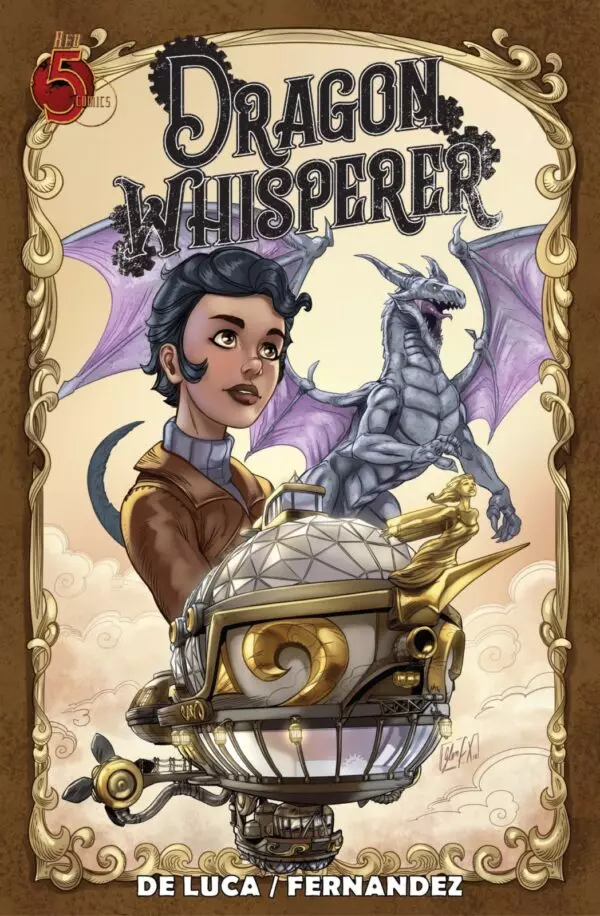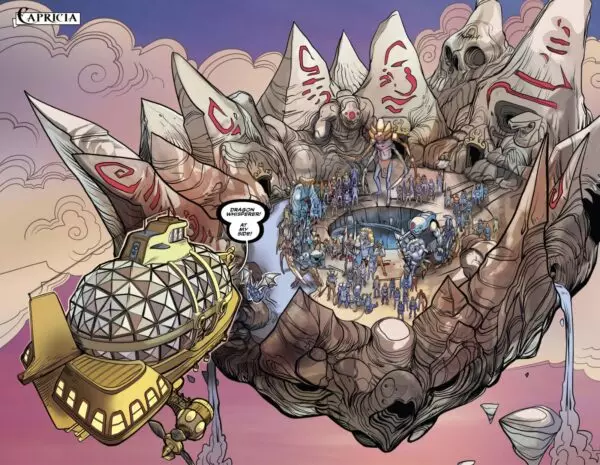Brad Cook chats with Dragon Whisperer writer Alex DeLuca…
Like many writers who have achieved any measure of success, Alex DeLuca started voraciously consuming prose fiction and comic books as a kid. He also started crafting his own tales, of course, becoming serious about the endeavor in the late 80s and early 90s.
After achieving a small break-through in the comic book industry in the mid-90s, he took a break from creative writing, only to revive the passion in the mid-2000s. In 2007, he came up with an early version of his steampunk adventure Dragon Whisperer and became serious about the project a decade later, enlisting an artist to draw the first issue.
After entertaining offers from several publishers, he landed at Red 5 Comics (yes, its founders share a love for Star Wars) and, as he told me, “Here I am, two volumes and 10 issues later.”
What’s Dragon Whisperer all about? Here’s the premise, straight from the Red 5 website:
“In a world of clockwork and steam, cursed airship captain, Alexander Faulk, endures his centuries-long quest for an end to his torment: a Dragon! His ceaseless pursuit bears scarce reward, that is until Faulk discovers the bridge between the world of man, and the world of monsters. Her name is Rosalinda Eberhardt, and she is the Dragon Whisperer.”
DeLuca took some time out of his busy schedule to chat with us about his career, the origin of Dragon Whisperer and its future, how the rock band Rush played into the inspiration for the comic book, and more.
Tell me about your career writing fiction, whether it’s been comic books, novels, or anything else in a similar vein.
I’ve been into creating stories and characters since I was a very young boy. My friend from elementary school and I created, wrote (and drew) our own superheroes, Lazer Laddie and Galactic Man (I was Lazer Laddie). Our call signs were “LL” and “GM.” Creative, I know.
Their origin stories were basically Superman’s origin story, times two. It just so happens that BOTH of our planets blew up, at the same time, and our parents shipped us off in spaceships towards Earth. We landed in the same spot and immediately got into a fight. That’s the only story I remember of LL and GM.
During the late ’80s/early ’90s I started to take writing seriously with the goal of publication. I would say my biggest prose inspirations of the time were spooky young adult horror writer John Bellairs and just about anything by Jane Yolen. I wrote stories feverishly about anything that came to mind. I saw something and I wrote a story about it. I submitted my fingers to the bone with hardly a bite from a publisher.
Being heavily into comics since I could crawl, I also tried my hand at writing comic scripts.
I came into my own as a connoisseur of how well a comic was written at, what was for me, an optimal time in comic history: The perfect storm of then editor-in-chief of Marvel Comics, Jim Shooter, Chris Claremont’s Uncanny X-Men, and the universe-expanding writing of the great Alan Moore, followed by the cherry on the cake of Neil Gaiman.
More writing, more rejections, but this time with a smattering of personalized responses with critiques. This was a huge positive.
I hit a few conventions seeing if I could meet publishers, but it wasn’t until San Diego Comic-Con 1994 that I met my dear friend Jimmie Robinson. This was before his amazing work with Image Comics like Code Blue, Bomb Queen and The Empty, to name a few. Back then, he was self-publishing Cyberzone, a pioneering LGBTQ comic masterwork.
I think it was during one of the many parties in some San Diego hotel room during which he said easily the most important thing ever to be said to me concerning my writing career. He heard I was getting into writing comics and he asked if I would like to write issue #6 of Cyberzone. I enthusiastically said yes.
This entire experience opened many doors for me. It got me pro status at conventions and it led to some other published comic short stories in magazines like Bloodthirsty Pirate Tales, Vampire Legends, and Horror Comics.
I took a long break from the late ’90s to the mid/late 2000s, after which I started to write comic scripts again. In 2007, I wrote the germ of what would eventually become Dragon Whisperer and received a few nibbles from publishers, but nothing concrete.
Then around mid 2017, I made a serious commitment. I updated the story a ton, wrote a script, found a terrific artist to draw an entire first issue, and then I submitted to publishers. I was blessed to get several offers from different publishers. I ended up going with Red 5 Comics and here I am 10 issues and two volumes later.
Why did you decide to tell the Dragon Whisperer story as a comic book?
Good question. 2012’s Clockwork Angels album, the final one from my favorite band, Rush, is a steampunk concept album. I love the misty dark and romantic imagery conjured by the lyrics. The late Neil Peart, the band’s drummer and primary songwriter, put it best: “Steampunk is a view of the future from the past.”
It upped my appreciation for the culture of steampunk. The potential for cool and beautiful steampunk imagery shown in a comic was just too tempting. Finding the genius artist Glen Fernandez to design and illustrate this comic was the ultimate inspiration, though.
There’s definitely a Moby Dick vibe to the initial setup of the story. Was that intentional?
Excellent observation. In fact, the earliest iteration of Dragon Whisperer was definitely in the Herman Melville/Robert Lewis Stevenson vein, with nary a wisp of steam nor a single punk in sight. It was really much more of an earth-based pirate yarn. Throwing in the steampunk spin just made the potential explode for me.
And, of course, there had to be a dragon in there. Dragons are like the pizzas of the fantasy genre: They’re always good.
Did anything else influence your telling of the story?
Well, my love for young adult fiction was key in its initial creation. I just love the eyes-wide-open sense of wonder in the genre, with characters not so young that everything is brand new and not so old as to be cynical.
The main character of Rosalinda is inspired by my dear friend in elementary school, Rosie. She was (and still is!) funny, quirky, creative, independent, full of zest for life, and astonishingly smart. She inspired me in so many ways.
The other characters were inspired by friends and snippets of fictional and historical archetypes I’ve experienced through the years.
How has the series sold so far? I assume it’s had a certain level of success, since you did a second volume.
Given that it is small press, and its very first issue came out in March of 2020, right at the onset of the pandemic, it has, to my eternal and humble surprise, sold moderately well. There is a small and wonderful fan base I am so grateful for.
The reality for most independent comic publishers is that individual comic issues, or “floppies,” are, on their own, more or less a break-even endeavor. Often they are considered promotional material for their forthcoming trade paperback or graphic novel release, which, given that trade paperbacks could be sold in more diverse and accessible marketplaces (versus mostly just comic shops and conventions for the floppies) and sell slightly better.
The good news for Dragon Whisperer is, it sold enough, and was successful enough, to warrant a second volume (and even a third!).
What was your storytelling goal for volume two, and what are your plans for future volumes in the series?
Volume two continues soon after the events of volume one and addresses and expounds upon the questions posed in it, but with a slightly more experienced cast of characters and more nuance as to why one partakes in a quest and the consequences of completing that quest.
My storytelling goal for volume two and all future volumes of Dragon Whisperer is growth and the facing, and acceptance, of change, for all the characters. As we humans now living our lives face change and, in one way or another, growth, so too do I hope for the characters of Dragon Whisperer. That and cool monsters, airships, romance, action and adventure and the thrill of a lifetime!
And oh yes, do I definitely have plans for another volume!
Anything else you want to add?
I would like to conclude by reminding readers of all things written that comics are a medium, not a genre. The big-budget movies that we’ve seen for the last several years are not “comic book movies.” They are superhero movies (which I happen to also enjoy very much). One does not call a movie based on a book a “book movie,” so why would one do so for a movie based on a comic?
Also, all the varied forms of this medium — manga, graphic novels, etc. — are all still comics. There is no one style better than any other, but there are styles that are different from others, and that’s a beautiful thing.
Just as in every other medium, comics have a uniqueness to them. There are ways of storytelling one can do in comics that are impossible in other media.
So, young or old or in between, pick up a comic. Any kind you want. I promise, you will see something new and wonderful and unexpected.
Many thanks to Alex DeLuca for taking the time for this interview.
Brad Cook
This post was originally published on this site be sure to check out more of their content.











